The Rise of Biometric Authentication in Technology
In today’s digital age, security and privacy have become more important than ever. With the increasing number of cyber threats and data breaches, traditional methods of authentication such as passwords and PINs are no longer enough to protect our personal information. This has led to the rising popularity of biometric authentication in technology.
What is Biometric Authentication?
Biometric authentication is a security process that relies on unique biological characteristics to verify a person’s identity. These characteristics include fingerprints, facial features, iris patterns, voice recognition, and even behavioral traits like typing patterns. By using biometric data, technology can accurately identify and authenticate individuals, making it a more secure and convenient method of access control.
The Benefits of Biometric Authentication
There are several benefits to using biometric authentication in technology:
Enhanced Security
Biometric authentication is significantly more secure than traditional methods like passwords and PINs. Since biometric data is unique to each individual, it is extremely difficult for hackers to replicate or steal. This makes it a highly effective way to protect sensitive information and prevent unauthorized access.
Convenience and Speed
Biometric authentication is also more convenient and faster for users. There is no need to remember complex passwords or carry around multiple authentication devices. With biometrics, individuals can simply use their unique characteristics to access their devices or accounts quickly and easily.
Improved User Experience
Biometric authentication offers a seamless and user-friendly experience. Users no longer have to worry about forgetting passwords or struggling with cumbersome authentication processes. This enhances overall satisfaction and makes technology more enjoyable to use.
Applications of Biometric Authentication
Biometric authentication is being used in a variety of technology applications:
Smartphones and Tablets
Many smartphones and tablets now come equipped with fingerprint sensors or facial recognition technology for unlocking the device. This provides an extra layer of security and makes it more convenient for users to access their devices.
Payment Systems
Biometric authentication is also being integrated into payment systems, allowing users to make secure transactions using their fingerprints or other biometric data. This reduces the risk of fraud and makes online shopping safer for consumers.
Workplaces
Many workplaces are adopting biometric authentication for access control and attendance tracking. Employees can use their fingerprints or facial features to enter secure areas or clock in and out of work, improving security measures and streamlining administrative processes.
Future Trends in Biometric Authentication
As technology continues to evolve, we can expect to see further advancements in biometric authentication:
Multi-Modal Biometrics
Multi-modal biometrics involve using multiple biometric characteristics for authentication, such as combining fingerprints with facial recognition. This provides an extra layer of security and enhances accuracy in identity verification.
Continuous Authentication
Continuous authentication is a proactive approach to security that monitors user behavior in real-time. By analyzing factors like typing speed, mouse movements, and facial expressions, technology can constantly verify the user’s identity and detect any suspicious activity.
AI and Machine Learning
Artificial intelligence and machine learning are being used to improve biometric authentication algorithms. These technologies can adapt to changes in biometric data over time, providing more accurate and reliable authentication methods.
Conclusion
Biometric authentication is quickly becoming the standard for security and access control in technology. With its enhanced security, convenience, and user experience, biometrics offer a reliable and efficient way to protect our personal information. As technology continues to advance, we can expect to see even more innovative applications of biometric authentication in the future.


